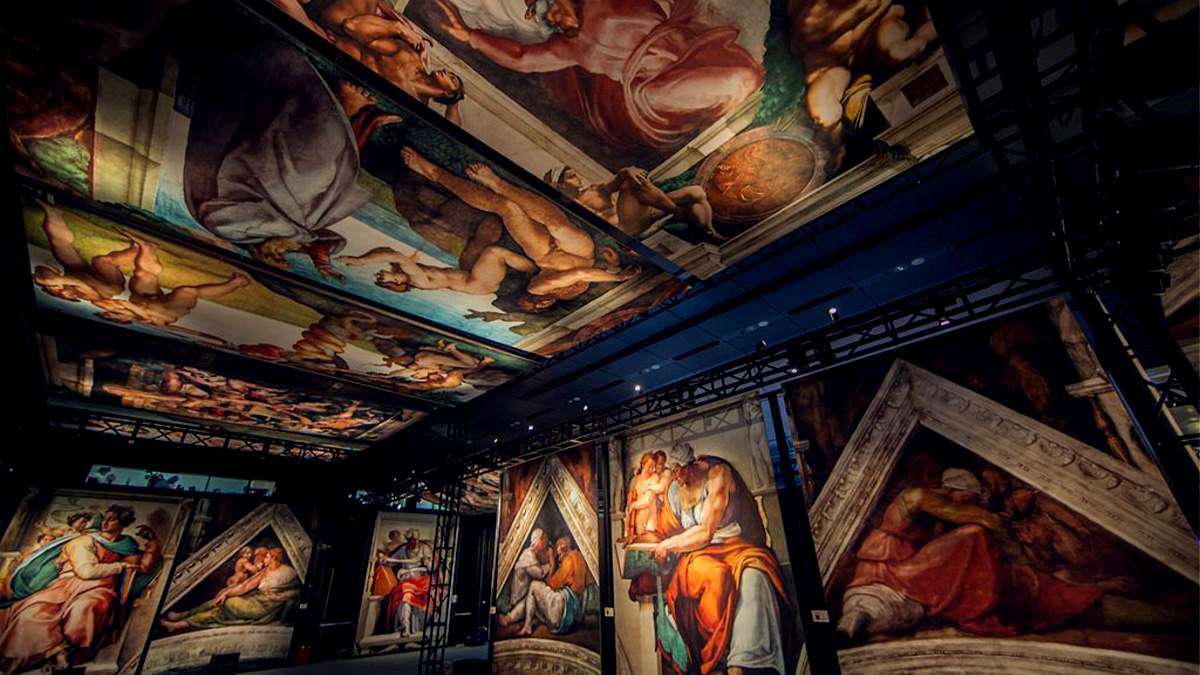cover photo from spot.ph/arts-culture/art-exhibits
The Philippines is hosting an international tour of Michelangelo’s Sistine Chapel ceiling paintings, showcasing high-definition pictures. According to Bernie Franco (2023), the exhibition located at the Estancia Mall in Capitol Commons, Pasig City, allows visitors to view the artwork at eye level, showcasing divine figures and expressive faces. Italian art has been renowned for its universal and timeless design contribution to modern society. And it shows with the inspiration design of Crown Asia’s properties. Crown Asia’s Condo in Las Piñas, Hermosa, is close to the exhibit as well.
Before diving more into the cultural significance of the Renaissance Art Movement in the Philippines. This article will explore an in-depth analysis of the life and artwork of one of the legendary artists of the Renaissance Period, Michaelangelo.
The Life of Michelangelo: A Renaissance Genius
One of the most important artists of the Italian Renaissance was Michelangelo di Lodovico Buonarroti Simoni, better known by his given name, Michelangelo. He was a sculptor, painter, famous architect, and poet who was born on March 6, 1475, in Caprese, Tuscany. He left a lasting impression on the fields of art and culture. In addition to receiving praise during his lifetime, his outstanding talent, commitment, and creative methods cemented his status as an artistic icon for future generations.
At a young age, Michelangelo’s artistic career began. His father gave him permission to study under the instruction of renowned painter Ghirlandaio since he understood his love for the arts. Michelangelo swiftly developed his painting abilities under this guidance, which would later come in handy in his artistic endeavors. However, his propensity for sculpture would end up being the thing that would define his legacy.
Michaelangelo: Famous Paintings, Architecture, and Sculptures
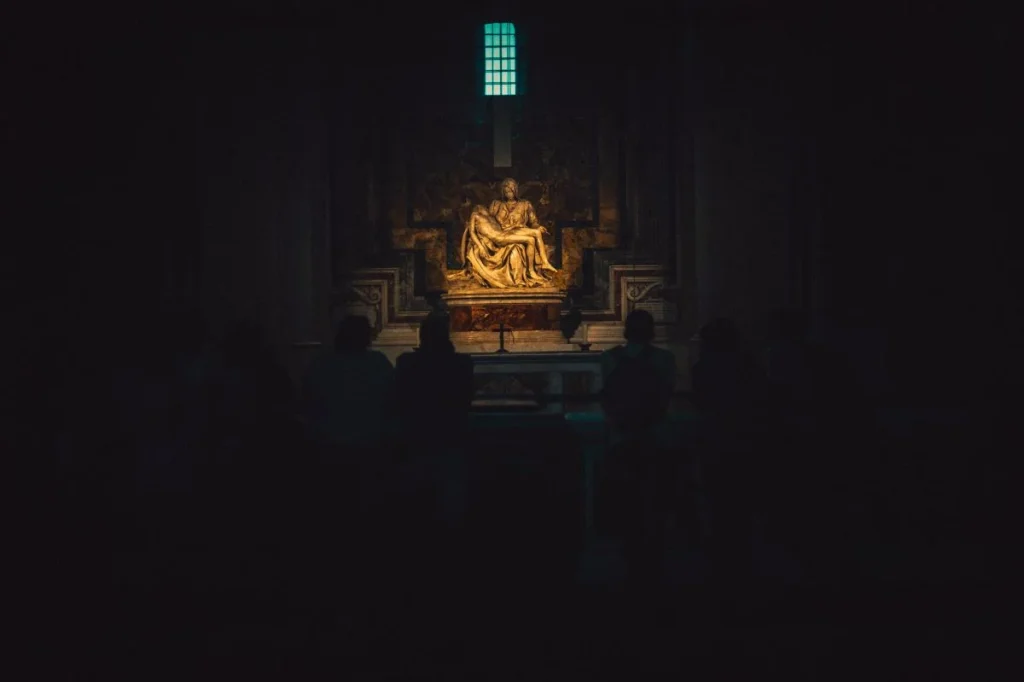
Pieta
The “Pieta,” a marble masterpiece that depicts the body of Jesus in the arms of his distraught mother Mary, was created by Michelangelo in his early twenties and would go on to become one of his most famous pieces. It demonstrated both his grasp of anatomy and his capacity to give unmatched emotional depth to stone. The “Pieta” demonstrated Michelangelo’s ability to arouse strong emotions in viewers in addition to establishing him as a rising star in the art world.
David
One of the most famous works of Renaissance sculpture and often regarded as one of the pinnacles of artistic success is Michelangelo’s David. This enormous marble sculpture has captured the interest of art lovers and historians for ages as a representation of human perfection, classical ideals, and artistic brilliance.
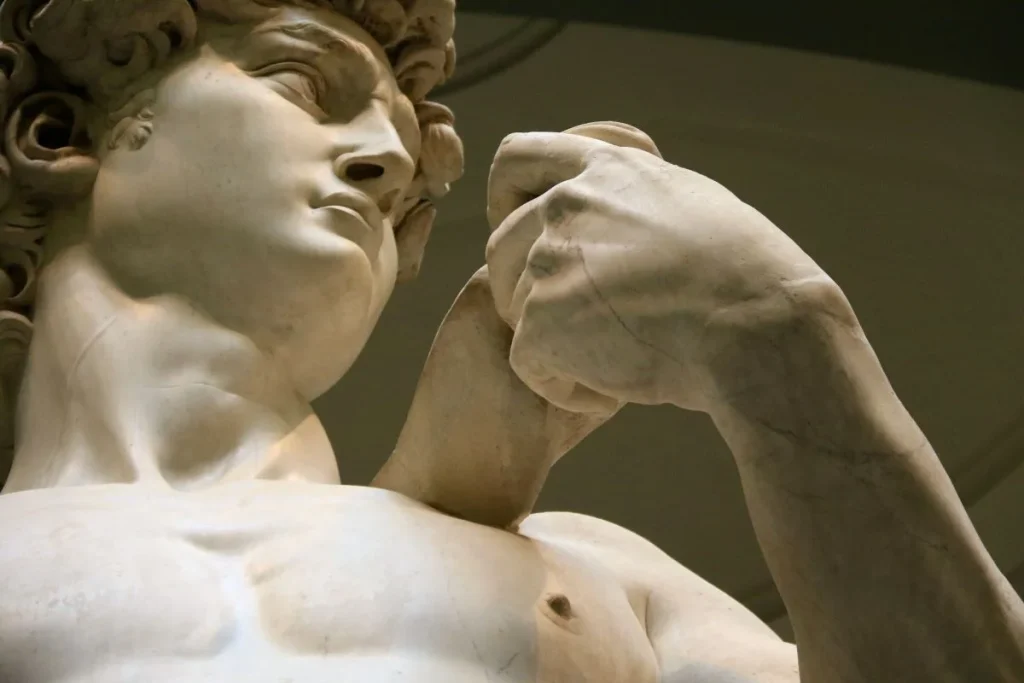
In 1501, when he was only 26 years old, Michelangelo started construction on the David after being given the Operai del Duomo commission for the Florence Cathedral. The sculpture was commissioned to decorate the Florence Cathedral’s roofline, but it was eventually moved to the Piazza della Signoria, where it is now displayed in front of the Palazzo Vecchio.
Technique-wise, Michelangelo’s approach to the David was likewise revolutionary. In contrast to conventional carving techniques, which included starting with a broad outline and then fine-tuning the details, Michelangelo preferred to carve directly on the marble block, allowing the figure to develop naturally. This “non-finito” technique, which is defined by leaving some elements of the sculpture in a raw, unfinished state, gave the David an unheard-of sensation of movement and energy, giving the impression that David could suddenly step off his pedestal.
Dome of St. Peter’s Basilica
Michelangelo was a skilled architect in addition to his artistic abilities. St. Peter’s Basilica in Rome’s dome, which he finished after his contemporaries Bramante died, is one of his architectural wonders. To further highlight his versatility and brilliance, one of the most recognizable architectural wonders of the globe was built with the help of his engineering expertise and creative designs.
The Crucifixion of St. Peter
A Christian tradition served as inspiration for the painting’s depiction of St. Peter’s martyrdom. The apostle was reportedly crucified upside down at his own request because he felt unworthy to die in the same manner as Jesus Christ, according to the apocryphal Acts of Peter. With amazing care, Michelangelo conveys this tragic and solemn moment, provoking strong feelings in people who view the fresco.
The fresco’s composition is eye-catching and unique. In contrast to conventional representations of crucifixions, Michelangelo decided to show St. Peter hanging by his feet from a vertical position. The apostle’s unworthiness in relation to Christ is highlighted by this unusual placement. The great attention to detail used in Michelangelo’s rendering of the crucifixion demonstrates his profound anatomical expertise.
The Madonna and Child with St. John and Angels
The timeless and well-known image of the Virgin Mary holding the Christ Child in her arms while being joined by St. John the Baptist, the boy cousin of Jesus, is depicted in “The Madonna and Child with St. John and Angels.” Cherubic angels are gathered around them and are adoringly looking at the divine newborn. The artwork captures a moment of intense parental love and spiritual importance in a setting of divine tranquility and tenderness.
Without question, the Madonna, who personifies elegance, purity, and maternal love, is the painting’s main subject. Her look, which emanates feelings of both solemnity and compassion, is expertly rendered by Michelangelo. Her intense love for her holy kid and her knowledge of the significant role he will play in the world are both evident in the way she looks at him. Her tender embrace of the Christ Child emphasizes the human aspect of the heavenly story by exuding a sense of maternal care and protection.
The Sistine Chapel ceiling painting
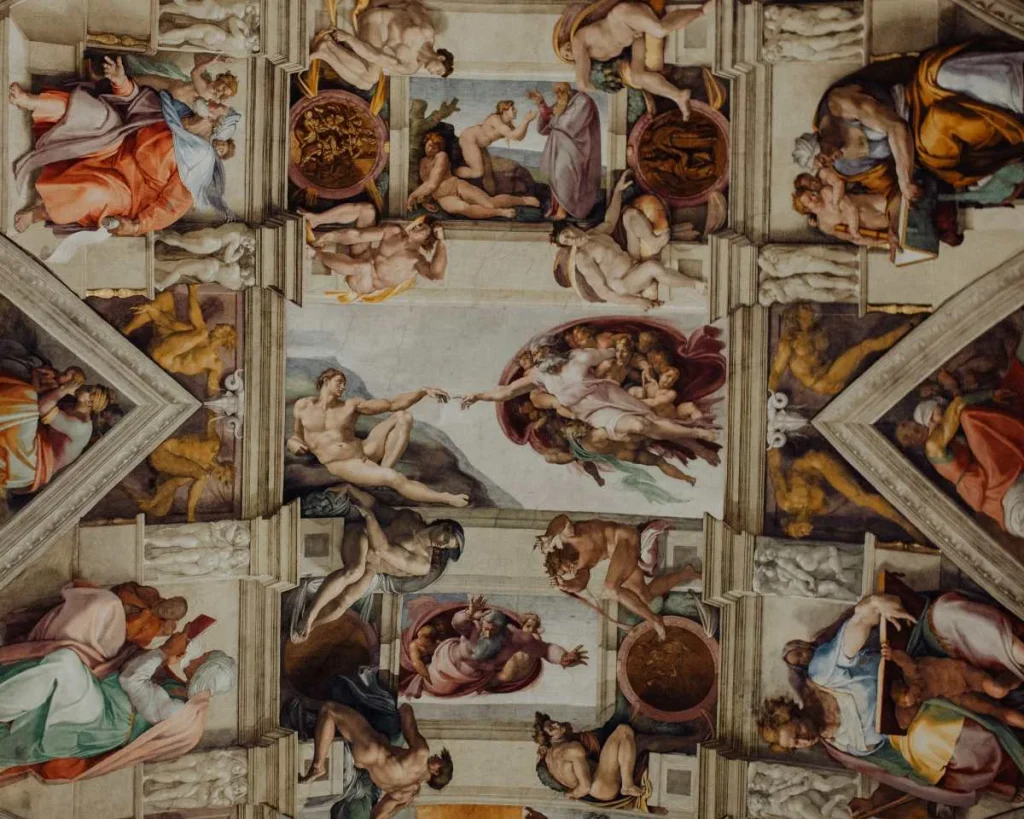
Not only was Michelangelo talented in sculpture, but he was also adept at painting. The Sistine Chapel is one of the most famous tourist destinations in Italy, especially when people are on their Europe Tour. However, the sacredness of the chapel is above the ceiling where the timeless art is still intact. The stunning ceiling of the Sistine Chapel in Vatican City is among his most recognizable and impressive works. The murals depicting episodes from the Book of Genesis decorated the chapel’s vaulted ceiling after he was commissioned by Pope Julius II to paint the ceiling. Michelangelo had to work on his back, defying gravity, while producing some of the most remarkable and exquisite artwork in history during the four years it needed to accomplish this arduous undertaking. Michelangelo’s reputation as a great visionary was cemented by the frescos’ brilliant hues, minutely rendered figures, and expressive facial expressions.
The Details of the Sistine Chapel
Michelangelo worked ceaselessly for four years, from 1508 to 1512, painting the ceiling while frequently reclining on his back on scaffolding. He took an innovative and ambitious approach to the task. In order to capture crucial moments of creation and humanity’s relationship with the divine, he decided to show events from the Book of Genesis.
The Sistine Chapel’s ceiling is a harmonic symphony of interconnected pictures rather than merely a collection of isolated frescoes. A coherent and visually spectacular narrative is created by the seamless transition between each scene, which reflects the relationship between God and humanity, the conflict between good and evil, and the journey of human souls seeking redemption.
In addition to the main story, Michelangelo decorated the spaces in between the scenes with amazing prophetic and sibyl images. These individuals, who sit atop colossal painted thrones, link the divine revelations of the past with the Christian present by providing a visual picture of Old Testament predictions and classical knowledge.
The Creation of Adam
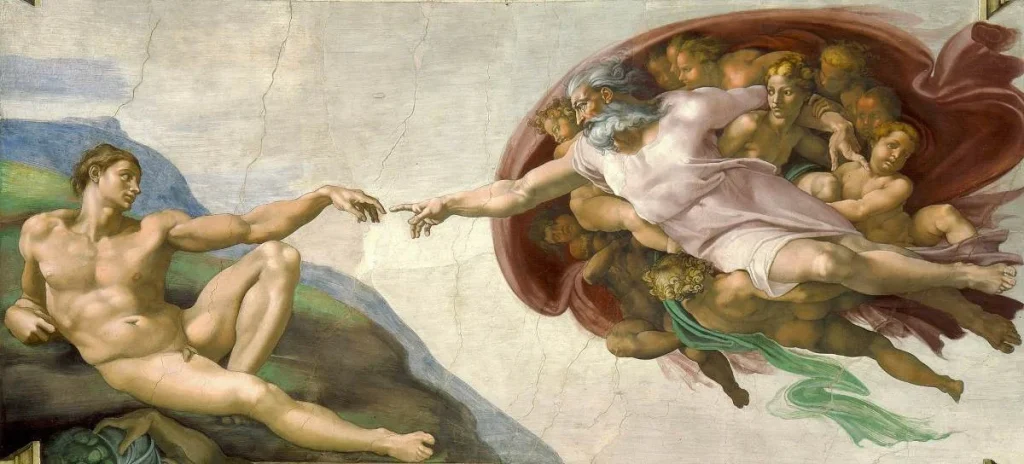
photo from news.artnet.com/art-world/
The classic “Creation of Adam,” depicting the moment when God gave the first man life, is the focal point of the ceiling. In this image, God’s and Adam’s hands are almost touching. One of the most iconic and significant representations in art history can be found in this one image. This artwork perfectly captures the divine power and human weakness that define Michelangelo’s artistic brilliance.
Other detailed and equally breathtaking paintings, each depicting a scene from the biblical story, surround “The Creation of Adam.” These scenes include “The Creation of Eve,” “The Temptation and Expulsion from Eden,” “The Sacrifice of Noah,” and “The Flood.” Michelangelo’s capacity to depict nuanced emotions, dramatic movement, and accurate anatomical forms distinguishes these frescoes as among the most outstanding works in art history.
The central focus of the composition is Adam and God, which are encircled by a celestial background. God is pictured as a large, commanding figure, with flowing clothes that billow in the wind. His extended arm and stern gesture serve as symbols of His omnipotent dominion and creative ability. He conveys the gravity of this sacred act of conception by his expression, which is both determined and empathetic.
While Adam’s body softly curves in response to the divine touch, he is lying in a calm and exposed position. In waiting for the gift of life and the infusion of divine consciousness, his passive posture marks the first stage of human existence. Adam’s closed eyes represent his impending spiritual awakening as he experiences God’s divine spark.
The representation of God’s angelic company around Him in “The Creation of Adam” is one of its most interesting elements. The angels appear to be conveying God’s divine spirit toward Adam as they engage in a frenetic and whirling dance. Their presence enhances the scene’s celestial ambiance, underscoring the act’s divine origin and illuminating the connection between the heavenly and terrestrial planes.
The fresco’s background architecture is another interesting feature. Michelangelo creates the appearance of a vast cosmic expanse by incorporating architectural details and a background made up of whirling drapery. The positioning of the characters and drapery conveys a feeling of depth and movement, creating the idea that the action is taking place in a large cosmic theater.
The Last Judgment
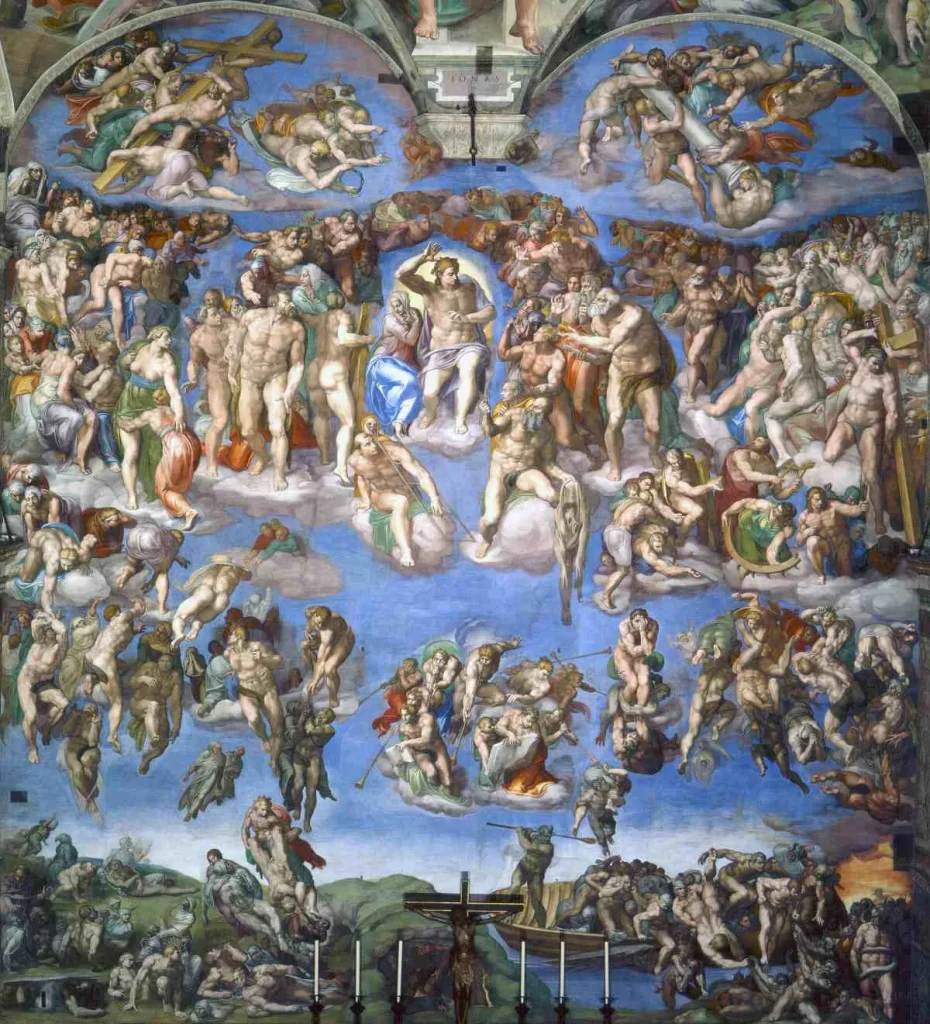
photo from en.wikipedia.org/wiki/The_Last_Judgment
A plethora of angels, saints, and apostles surround Christ as he descends from the skies in the painting, which symbolizes his second coming. The upper portion of the artwork is dominated by his figure, which exudes both heavenly authority and compassion. Christ’s extended arms represent both judgment and redemption by replicating the gesture of his crucifixion.
Three major sections make up the composition. Christ sits in the middle, presiding over the judgment, with the condemned being thrown down to hell on his left and the righteous ascending to heaven on his right. The upright individuals appear to be joyfully and gratefully accepting their salvation as they are dressed in serene and brilliant hues. The doomed souls, on the other hand, are portrayed in various degrees of despair and sorrow, with pained expressions.
The depiction of the human body in “The Last Judgment” is among its most astounding features. The wide range of figures showcases Michelangelo’s profound knowledge of anatomy and his skill in evoking real emotions through brushstrokes. The righteous figures, dressed in serene and vibrant hues, appear to be embracing their salvation with joy and gratitude. Everybody, whether muscular or emaciated, is rendered with astounding realism, showcasing the artist’s genius in capturing the human spirit in its most vulnerable and transcendent moments.
The Influence of Michaelangelo on the Pop Culture

cover photo from spot.ph/arts-culture/art-exhibits
Beyond his artistic abilities, Michelangelo was a skilled architect. The dome of St. Peter’s Basilica in Rome, which he finished after the passing of his contemporary Bramante, is one of his architectural wonders. His versatility and brilliance were further illustrated by the fact that one of the most recognizable architectural wonders of the globe was built using his engineering expertise and creative designs.
“The Sistine Chapel Ceiling” is still a work of incredible human achievement, an example of brilliant art, and a manifestation of unwavering faith. Millions of tourists and art lovers from all over the world are still inspired by and enthralled by Michelangelo’s masterwork. It serves as a tribute to the enduring power of art and its capacity to transcend time, culture, and religious borders as well as a reminder of the potential of human creation. The ceiling of the Sistine Chapel serves as a magnificent homage to the enduring bond between humanity and the divine and calls us to consider the ineffable magnificence of the human soul.
Influence on Philippine Architecture
The emphasis on proportion, balance, and symmetry in Italian Renaissance architecture was one of its most notable characteristics. Churches, government buildings, and ancestral homes among other Philippine constructions all adopted these concepts. Grand arches, domes, and colonnades were used in Spanish colonial architecture in the Philippines, which was influenced by the Italian Renaissance and gave buildings a regal and intimidating aspect.
The design of colonial churches is the most striking illustration of the Italian Renaissance‘s influence on Philippine architecture. Being a country with a large Catholic population, the Philippines has seen many churches built over the years. Italian Renaissance architecture was frequently included in the design of these churches, especially in the façade and interiors.
In conclusion, Michelangelo, a genius of the arts, lived and worked during the Italian Renaissance, which was very much alive and well. He left a mark on the world of art that will never be forgotten, from his early sculptures to the spectacular paintings on the dome of the Sistine Chapel and his architectural triumphs. His legacy serves as a reminder that exceptional talent knows no bounds and can transcend cultural and temporal barriers. It stands as a testament to the power of human ingenuity, inventiveness, and perseverance. The legacy of Michelangelo’s life and creations will forever stand as a testament to the importance of aiming high and the lasting power of human expression.
Related Blog: Italian Concept Never Gets Out of Style


